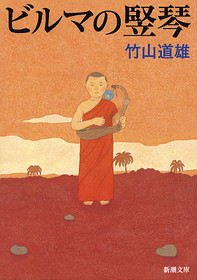174:, the musical instrument adopted by the soldier. The novel is more open than the 1956 film about Japan's responsibility for the war. In Takeyama's novel one of the soldiers talks of the "terrible trouble" which Japan has brought to Burma, and the hero soldier-become monk Mizushima criticizes Japan's colonial ambitions as "wasteful desires" and the Japanese having "forgotten the most important things in life", a perspective which is downplayed in the film.
239:
but the
British think he is dead and leave him behind. He recovers with the help of a monk before stealing the monk's clothes and returning to the vicinity of the POW camp. But Mizushima does not reveal his identity to his unit: having seen all the bodies of soldiers scattered around the Burmese ...
238:
Philip A. Seaton Japan's
Contested War Memories: The 'Memory Rifts' in Historical ...- 2007 1134150059 -"Mizushima volunteers to persuade a group of Japanese soldiers who are still resisting to surrender. Mizushima's attempts fail, so the British launch an artillery assault. Mizushima is wounded,
228:
Keiko I. McDonald - From Book to Screen: Modern
Japanese Literature in Films 1315292394 2016 " Among them was Michio Takeyama's Biruma no tategoto (The harp of Burma). Published in 1946, this novel's mission was frankly didactic: to inspire youth with hope for the future of a nation struggling to
169:
in July 1945, Mizushima is a harp-playing
Japanese P.O.W. who volunteers to persuade a resisting Japanese unit to surrender. His attempt fails and in the ensuing battle he is left behind, assumed dead. Mizushima takes the clothes of a Buddhist monk, but then reappears as the monk to his former
170:
comrades. His comrades, led by
Captain Inouye, gift the monk a blue parakeet trained to say "Mizushima come home", but Mizushima elects to stay behind in Burma to bury the dead. The title of the book comes from the
161:
Takeyama wrote the story wanting to give young readers hope after defeat in WWII by emphasizing the traditional
Buddhist ideal of altruism, embodied in a soldier hero, Mizushima. Captured by the
34:
229:
survive defeat in war. Takeyama sought to do this by emphasizing the traditional value system, the
Buddhist ideal of altruism, as embodied in his soldier hero, Mizushima. ...
205:, a color Japanese film, also by Kon Ichikawa – the number one Japanese film on the domestic market in 1985 and the second largest Japanese box office hit up to that time
312:
322:
133:– one released in 1956 and a color remake in 1985. Both films were major successes. A translation of the novel into English by
271:
182:
There are two film adaptations and an animated television version (all with the same title as the novel in
Japanese):
150:
87:
337:
332:
20:
199:
186:
317:
138:
327:
196:– a critical success nominated for the Academy Award for Best Foreign Language Film of 1956
8:
162:
122:
57:
166:
288:
253:
146:
82:
126:
47:
134:
306:
257:
292:
193:
130:
211:(1986), a Japanese animated television adaptation by Nippon Animation Co.
274:." Central Park Media. February 8, 2003. Retrieved on October 10, 2009.
129:. It was first published in 1946 and was the basis of two films by
33:
142:
171:
304:
108:
102:
264:
32:
285:Animated classics of Japanese literature
16:1946 children's novel by Michio Takeyama
305:
192:, a black-and-white Japanese film by
13:
313:Japanese novels adapted into films
14:
349:
323:Novels set during World War II
277:
242:
232:
222:
177:
1:
215:
21:Burmese Harp (disambiguation)
7:
250:ビルマの竪琴 / Biruma no tategoto
109:
10:
354:
18:
163:British led Indian forces
139:Charles E. Tuttle Company
137:was published in 1966 by
103:
81:
73:
63:
53:
43:
31:
338:Tuttle Publishing books
156:
333:Burma in World War II
141:in cooperation with
19:For other uses, see
28:
318:Central Park Media
272:New Video Releases
167:Surrender of Japan
110:Biruma no tategoto
26:
209:The Harp of Burma
93:
92:
74:Publication place
27:The Burmese Harp
345:
297:
296:
281:
275:
268:
262:
261:
246:
240:
236:
230:
226:
201:The Burmese Harp
188:The Burmese Harp
165:, following the
123:children's novel
115:, also known as
114:
112:
106:
105:
97:The Burmese Harp
65:Publication date
58:children's novel
38:Japanese edition
36:
29:
25:
353:
352:
348:
347:
346:
344:
343:
342:
303:
302:
301:
300:
283:
282:
278:
269:
265:
248:
247:
243:
237:
233:
227:
223:
218:
180:
159:
127:Michio Takeyama
100:
66:
48:Michio Takeyama
39:
24:
17:
12:
11:
5:
351:
341:
340:
335:
330:
325:
320:
315:
299:
298:
276:
263:
241:
231:
220:
219:
217:
214:
213:
212:
206:
197:
179:
176:
158:
155:
135:Howard Hibbett
91:
90:
85:
79:
78:
75:
71:
70:
67:
64:
61:
60:
55:
51:
50:
45:
41:
40:
37:
15:
9:
6:
4:
3:
2:
350:
339:
336:
334:
331:
329:
326:
324:
321:
319:
316:
314:
311:
310:
308:
294:
290:
286:
280:
273:
267:
259:
255:
251:
245:
235:
225:
221:
210:
207:
204:
202:
198:
195:
191:
189:
185:
184:
183:
175:
173:
168:
164:
154:
152:
151:0-8048-0232-7
148:
144:
140:
136:
132:
128:
124:
120:
119:
118:Harp of Burma
111:
99:
98:
89:
88:0-8048-0232-7
86:
84:
80:
76:
72:
68:
62:
59:
56:
52:
49:
46:
42:
35:
30:
22:
284:
279:
266:
249:
244:
234:
224:
208:
200:
194:Kon Ichikawa
187:
181:
160:
131:Kon Ichikawa
117:
116:
96:
95:
94:
328:1946 novels
178:Adaptations
307:Categories
216:References
258:122821052
293:56748937
121:, is a
291:
256:
203:(1985)
190:(1956)
149:
143:UNESCO
104:ビルマの竪琴
44:Author
172:saung
77:Japan
54:Genre
289:OCLC
254:OCLC
157:Plot
147:ISBN
83:ISBN
69:1946
153:).
125:by
309::
287:.
252:.
107:,
295:.
270:"
260:.
145:(
113:)
101:(
23:.
Text is available under the Creative Commons Attribution-ShareAlike License. Additional terms may apply.
